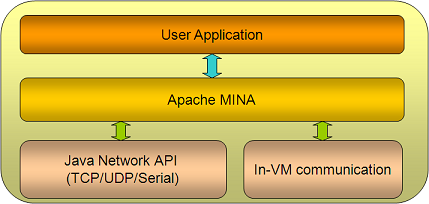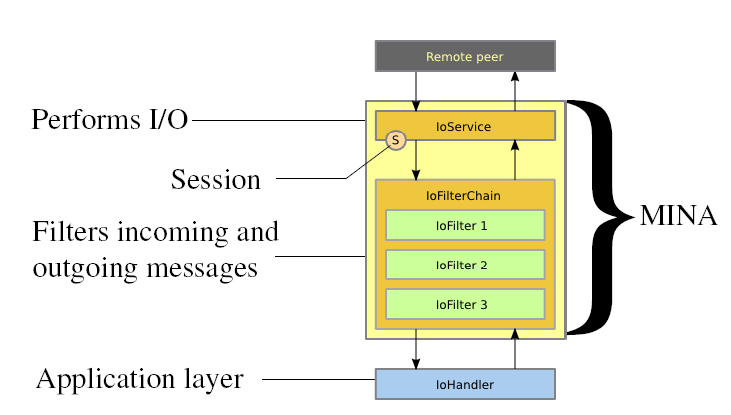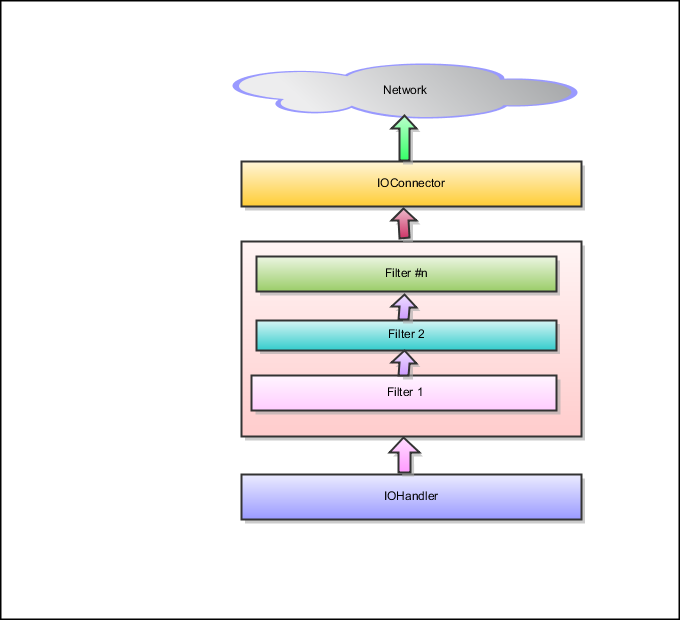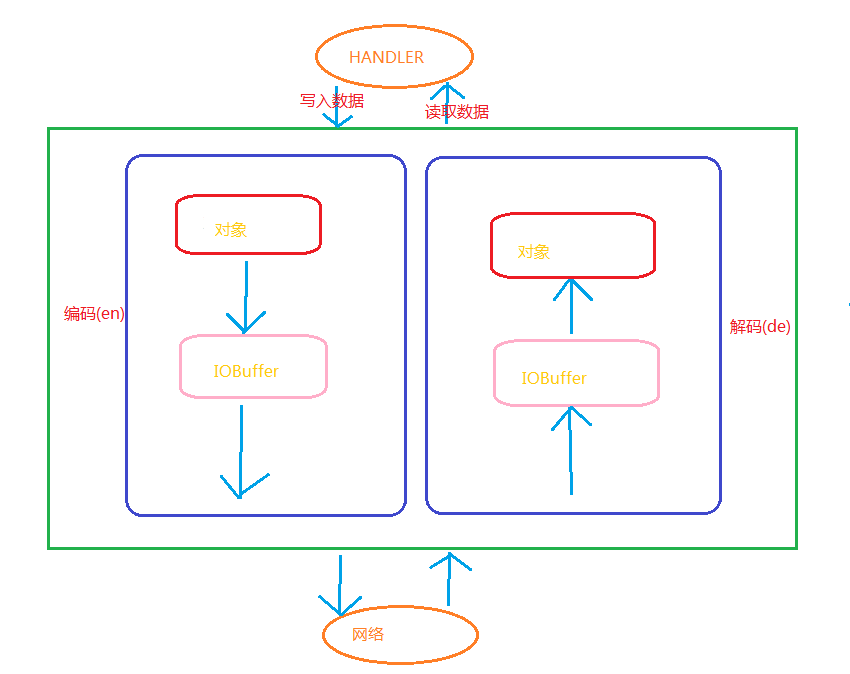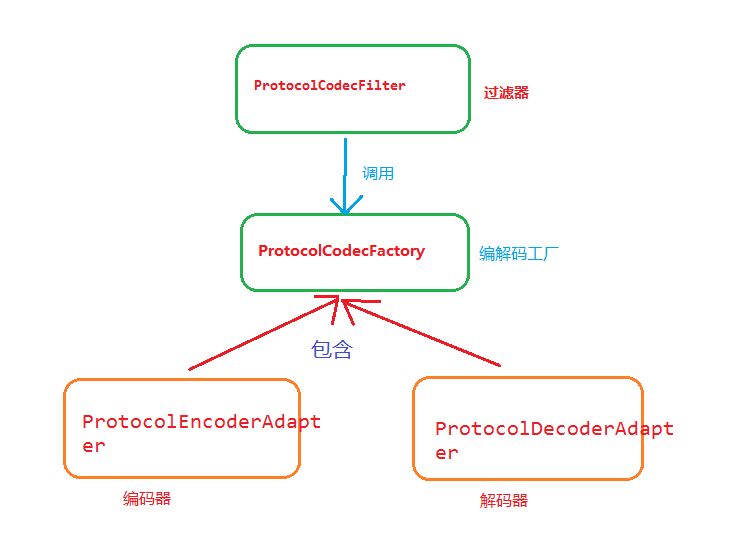一。MINA架构
Apache Mina是一个能够帮助用户开发高性能和高伸缩性网络应用程序的框架。它通过Java nio技术基于TCP/IP和UDP/IP协议提供了抽象的、事件驱动的、异步的API
MINA是应用程序(服务端和客户端)和网络层间(TCP UDP 内存通信)的桥梁
深入mina内部架构
mina分为以下三层:
- IOService 用于接受连接 处理io请求
- IOFilterChain 用于网络间字节数组和数据结构之间的转换 (读:将字节转换为对象传给应用层 ,写:将应用对象转换字节写入流)
- IOHandler 用于自己开发的应用业务逻辑 可以监听各种io事件(缓冲区有数据读,创建session,打开session,session空闲等)
开发mina程序 需要以下步骤:
- 创建 IoService 选择已经存在的实现 (*Acceptor) 或者自定义实现
- 创建IOFilterChian选择已经实现的或者自定义实现的
- 创建IoHandler用于处理消息
二。MINA简单实例
所有的文字翻译和编码 参考官网(http://mina.apache.org/mina-project/userguide/user-guide-toc.html)
服务端:
使用IO Acceptor接受来自网络层连接 经过Filter过滤后 将转换的对象传给用户自定义Handler
添加maven依赖
<dependency>
<groupId>org.apache.mina</groupId>
<artifactId>mina-core</artifactId>
<version>2.0.6</version>
</dependency>
<dependency>
<groupId>org.slf4j</groupId>
<artifactId>slf4j-log4j12</artifactId>
<version>1.6.6</version>
</dependency>src/main/resource目录下添加log4j.properties
### set log levels ###
log4j.rootLogger = debug , stdout
### u8F93u51FAu5230u63A7u5236u53F0 ###
log4j.appender.stdout = org.apache.log4j.ConsoleAppender
log4j.appender.stdout.Target = System.out
log4j.appender.stdout.layout = org.apache.log4j.PatternLayout
log4j.appender.stdout.layout.ConversionPattern = %d{ABSOLUTE} %5p %c{1}:%L - %m%n代码实现:
package cn.et;
import java.io.IOException;
import java.net.InetSocketAddress;
import java.nio.charset.Charset;
import java.util.Date;
import org.apache.mina.core.service.IoHandler;
import org.apache.mina.core.session.IdleStatus;
import org.apache.mina.core.session.IoSession;
import org.apache.mina.filter.codec.ProtocolCodecFilter;
import org.apache.mina.filter.codec.textline.TextLineCodecFactory;
import org.apache.mina.filter.logging.LoggingFilter;
import org.apache.mina.transport.socket.nio.NioSocketAcceptor;
/**
* 服务端
* @author jiaozi
*
*/
public class MinaServer {
//端口
private static final int PORT = 8899;
public static void main(String[] args) throws IOException {
//NioSocketAcceptor是IOService实现类
NioSocketAcceptor server=new NioSocketAcceptor();
//绑定过滤器 一般如果传送的是文本 就是讲字节数组转换文本的过滤器 必须提供字符集 codec这样的名字可以随便写
server.getFilterChain().addLast("codec", new ProtocolCodecFilter(
new TextLineCodecFactory(Charset.forName("UTF-8"))
));
//添加日志打印过滤器
server.getFilterChain().addLast("logger", new LoggingFilter());
//每次获取一个连接就会产生一个session session可以设置一些参数 比如数据缓冲区大小 等待时间间隔
server.getSessionConfig().setReadBufferSize( 2048 );
server.getSessionConfig().setIdleTime(IdleStatus.BOTH_IDLE, 10 );
//设置回调函数 用于处理消息
server.setHandler(new IoHandler() {
//session被打开事件
public void sessionOpened(IoSession session) throws Exception {
System.out.println("session打开");
}
//如果没有消息读写 线程休眠一段时间 处理休眠时触发
public void sessionIdle(IoSession session, IdleStatus status) throws Exception {
System.out.println("session空闲");
}
public void sessionCreated(IoSession session) throws Exception {
System.out.println("开始创建session");
}
public void sessionClosed(IoSession session) throws Exception {
System.out.println("session被关闭");
}
public void messageSent(IoSession session, Object message) throws Exception {
System.out.println("有消息被发送出去");
}
public void messageReceived(IoSession session, Object message) throws Exception {
System.out.println("接受到一个消息 :"+message);
session.write(new Date());
}
public void exceptionCaught(IoSession session, Throwable cause) throws Exception {
cause.printStackTrace();
}
});
server.bind(new InetSocketAddress(PORT));
}
}
客户端:
使用IO Connector连接服务端 同理将来自服务端消息 通过转换传给自定义handler
telnet localhost 8899输入任何消息 发现 服务端控制台获取到了输入的消息 同时session相关的事件都触发 系统日志打印一些事件
telnet上输出了服务器打印的日期 关闭telnet客户端 触发服务端session关闭事件
编码实现:
package cn.et;
import java.io.IOException;
import java.net.InetSocketAddress;
import java.nio.charset.Charset;
import java.util.Date;
import org.apache.mina.core.future.ConnectFuture;
import org.apache.mina.core.service.IoHandler;
import org.apache.mina.core.session.IdleStatus;
import org.apache.mina.core.session.IoSession;
import org.apache.mina.filter.codec.ProtocolCodecFilter;
import org.apache.mina.filter.codec.textline.TextLineCodecFactory;
import org.apache.mina.filter.logging.LoggingFilter;
import org.apache.mina.transport.socket.nio.NioSocketConnector;
/**
* 服务端
* @author jiaozi
*
*/
public class MinaClient {
//端口
private static final int PORT = 8899;
public static void main(String[] args) throws IOException {
//NioSocketAcceptor是IOService实现类
NioSocketConnector client=new NioSocketConnector();
//绑定过滤器 一般如果传送的是文本 就是讲字节数组转换文本的过滤器 必须提供字符集 codec这样的名字可以随便写
client.getFilterChain().addLast("codec", new ProtocolCodecFilter(
new TextLineCodecFactory(Charset.forName("UTF-8"))
));
//添加日志打印过滤器
client.getFilterChain().addLast("logger", new LoggingFilter());
//每次获取一个连接就会产生一个session session可以设置一些参数 比如数据缓冲区大小 等待时间间隔
client.getSessionConfig().setReadBufferSize( 2048 );
client.getSessionConfig().setIdleTime(IdleStatus.BOTH_IDLE, 10 );
//设置回调函数 用于处理消息
client.setHandler(new IoHandler() {
//session被打开事件 就是连接上 发送消息给session
public void sessionOpened(IoSession session) throws Exception {
session.write("hello server");
}
//如果没有消息读写 线程休眠一段时间 处理休眠时触发
public void sessionIdle(IoSession session, IdleStatus status) throws Exception {
System.out.println("session空闲");
}
public void sessionCreated(IoSession session) throws Exception {
System.out.println("开始创建session");
}
public void sessionClosed(IoSession session) throws Exception {
System.out.println("session被关闭");
}
public void messageSent(IoSession session, Object message) throws Exception {
System.out.println("有消息被发送出去");
}
public void messageReceived(IoSession session, Object message) throws Exception {
System.out.println("接受到一个消息 :"+message);
}
public void exceptionCaught(IoSession session, Throwable cause) throws Exception {
cause.printStackTrace();
}
});
ConnectFuture future = client.connect(new InetSocketAddress("localhost",8899));
future.awaitUninterruptibly();
IoSession session = future.getSession();
}
}三。过滤器简介
过滤器相关内容参考官网 http://mina.apache.org/mina-project/userguide/ch5-filters/ch5-filters.html
过滤器表示在handler进行操作之前过滤拦截 必须实现
IoFilterAdapter iofilter是一个非常重要的Mina核心结构。它过滤ioservice和iohandler之间的所有I/o事件和请求。如果您有web应用程序编程的经验,您可以放心地认为它是servlet过滤器的近亲。许多开箱即用过滤器是通过使用Out-the-box过滤器 例如:
- 所有事件和请求的loggingfilter日志
- ProtocolCodecFilter 编解码器可以装ByteBuffer和应用层对象消息
- 压缩过滤器压缩所有数据。
- sslfilter添加了SSL-TLS-STARTTLS支持。等等!
1.实现简单的日志过滤器
package cn.et;
import org.apache.mina.core.filterchain.IoFilterAdapter;
import org.apache.mina.core.session.IoSession;
import org.apache.mina.core.write.WriteRequest;
public class MyLogFilter extends IoFilterAdapter {
@Override
public void sessionCreated(NextFilter nextFilter, IoSession session) throws Exception {
//过滤器必须调用下一个过滤器的相同方法 super方法中就是 你也可以自己写
//nextFilter.sessionCreated(session);
System.out.println("自定义过滤器:session被创建"+session.getId());
super.sessionCreated(nextFilter, session);
}
@Override
public void sessionClosed(NextFilter nextFilter, IoSession session) throws Exception {
System.out.println("自定义过滤器:session被关闭"+session.getId());
super.sessionClosed(nextFilter, session);
}
@Override
public void messageReceived(NextFilter nextFilter, IoSession session, Object message) throws Exception {
System.out.println("自定义过滤器:接受到消息"+message);
super.messageReceived(nextFilter, session, message);
}
@Override
public void messageSent(NextFilter nextFilter, IoSession session, WriteRequest writeRequest) throws Exception {
System.out.println("自定义过滤器:发送消息"+ writeRequest.getMessage());
super.messageSent(nextFilter, session, writeRequest);
}
}需要将过滤器的实例添加到IOService 的过滤器链中
server.getFilterChain().addLast("mylogger", new MyLogFilter());运行 实例检测发现session打开关闭 接发消息都会输出对应消息
2.通过编解码器实现自定义协议
编解码原理参考下图
数据写入时 自定义handler写入对象类型 编码器将对象转换成IOBuffer对象
数据读取时 将网络传入的IOBuffer对象解码成对象传入handler 供用户操作
实现编解码器实现类图:
编码实现 需要实现编解码工厂 编码器和解码器 (考虑只读到了部分包的问题 半包【留到下一次直到读完】 粘包【两个不同的包 互相有一半数据】)
这里实现一个发送文件和文件消息的编解码器(解码 文件接收暂时未实现 有时间再补上)
编码器
package cn.et.codec;
import java.io.File;
import java.io.IOException;
import java.nio.ByteBuffer;
import java.nio.channels.FileChannel;
import java.nio.charset.Charset;
import java.nio.charset.CharsetEncoder;
import java.nio.file.Path;
import java.nio.file.Paths;
import java.nio.file.StandardOpenOption;
import org.apache.mina.core.buffer.IoBuffer;
import org.apache.mina.core.session.IoSession;
import org.apache.mina.filter.codec.ProtocolEncoderAdapter;
import org.apache.mina.filter.codec.ProtocolEncoderOutput;
/**
* 实现编码器
* @author jiaozi
*
*/
public class ImMsgEncode extends ProtocolEncoderAdapter {
//使用utf-8字符集
public static CharsetEncoder chaset=Charset.forName("UTF-8").newEncoder();
//文件写入单位
public static final int BLOCK_SIZE=1024*1024;
/**
* 用于将handler传入的对象转换成字节写入底层网络
*/
public void encode(IoSession session, Object message, ProtocolEncoderOutput out) throws Exception {
ImMsg imMsg=(ImMsg)message;
//其中 int类型的内容长度和 内容类型占了 5个字节 加上内容
IoBuffer buffer=IoBuffer.allocate(imMsg.getContentLength()+5).setAutoExpand(true);
//IOBuffer支持读写各种数据类型的
buffer.put(imMsg.getMsgType());
//如果是文本消息 直接全部发送
if(1==imMsg.getMsgType()) {
//获取字符串的字节长度
buffer.putInt(imMsg.getContent().getBytes(chaset.charset()).length);
//写入字符串
buffer.putString(imMsg.getContent(), chaset);
buffer.flip();
out.write(buffer);
out.flush();
}
}
}
package cn.et.codec;
import java.nio.charset.Charset;
import java.nio.charset.CharsetDecoder;
import org.apache.mina.core.buffer.IoBuffer;
import org.apache.mina.core.session.AttributeKey;
import org.apache.mina.core.session.IoSession;
import org.apache.mina.filter.codec.ProtocolDecoderAdapter;
import org.apache.mina.filter.codec.ProtocolDecoderOutput;
/**
* 解码 将底层网路字节数组转换成java对象
* decode方法可能被调用多次 可能有半包 第一次发送过来一部分 第二次发送过来一部分 不管几次 都是同一个session
* 可以将数据缓存成一个对象 供下次使用 处理完
* 0 5 abcde 0 3 123
*
*
*
* @author jiaozi
*
*/
public class ImMsgDecode extends ProtocolDecoderAdapter {
//使用utf-8字符集
public static CharsetDecoder chaset=Charset.forName("UTF-8").newDecoder();
//文件写入单位
public static final int BLOCK_SIZE=1024*1024;
private int bufferLength = 128;
//存储在session中的key
private final AttributeKey CONTEXT = new AttributeKey(getClass(), "context");
public void decode(IoSession session, IoBuffer in, ProtocolDecoderOutput out) throws Exception {
Context ctx = getContext(session);
ctx.append(in);
ctx.getBuffer().flip();
//ctx一直处于写模式 remaining表示剩余多少空间可写 容量-剩余 就是使用的也就是长度
int size=ctx.getBuffer().remaining();
//表示大于5个字节就可以读取头和体了
if(size>=5 ) {
//没有读取过头数据 可以读取head数据
if(ctx.getImMsg().getContentLength()==-1) {
//读取类型
byte type=ctx.getBuffer().get();
ctx.getImMsg().setMsgType(type);
//读取内容
int contentLength=ctx.getBuffer().getInt();
ctx.getImMsg().setContentLength(contentLength);
}
//判断读取到了头
if(ctx.getImMsg().getContentLength()!=-1) {
//读取完成了 写入到上层应用handler 调用out.write
if(size>=ctx.getImMsg().getContentLength()+5) {
String content=new String(ctx.getBuffer().array(),5,ctx.getImMsg().getContentLength(),chaset.charset());
ctx.getImMsg().setContent(content);
out.write(ctx.getImMsg());
ctx.getBuffer().clear();
//如果存在遗留字节 就是粘包 就是下一次的数据 清空Context留给下一次
int leaveLength=size-(ctx.getImMsg().getContentLength()+5);
if(leaveLength>0) {
session.removeAttribute(CONTEXT);
byte[] b=new byte[leaveLength];
ctx.getBuffer().get(b, ctx.getImMsg().getContentLength()+5, leaveLength);
ctx.getBuffer().clear();
ctx.getBuffer().put(b);
}
}
}
}
//调用过flip 切换回写模式
ctx.writeMode();
}
public Context getContext(IoSession session) {
Context ctx = (Context) session.getAttribute(CONTEXT);
if(ctx==null) {
ctx=new Context(bufferLength);
session.setAttribute(CONTEXT, ctx);
}
return ctx;
}
//用于保存当前这次解析的上下文对象
class Context{
private ImMsg imMsg;
private IoBuffer buffer;
public IoBuffer getBuffer() {
return buffer;
}
//调用了flip后切换回写入模式
public void writeMode() {
buffer.position(buffer.limit());
buffer.limit(buffer.capacity());
}
private Context(int bufferLength) {
buffer = IoBuffer.allocate(bufferLength).setAutoExpand(true);
imMsg=new ImMsg();
}
public void append(IoBuffer in) {
buffer.put(in);
}
public ImMsg getImMsg() {
return imMsg;
}
}
}
package cn.et.codec;
import org.apache.mina.core.session.IoSession;
import org.apache.mina.filter.codec.ProtocolCodecFactory;
import org.apache.mina.filter.codec.ProtocolDecoder;
import org.apache.mina.filter.codec.ProtocolDecoderAdapter;
import org.apache.mina.filter.codec.ProtocolEncoder;
import org.apache.mina.filter.codec.ProtocolEncoderAdapter;
/**
* 编解码工厂
* @author jiaozi
*
*/
public class ImMsgProtocolCodecFactory implements ProtocolCodecFactory {
private ProtocolDecoderAdapter decoder;
private ProtocolEncoderAdapter encoder;
public ImMsgProtocolCodecFactory(ProtocolDecoderAdapter decoder, ProtocolEncoderAdapter encoder) {
this.decoder = decoder;
this.encoder = encoder;
}
public ProtocolEncoder getEncoder(IoSession session) throws Exception {
// TODO Auto-generated method stub
return this.encoder;
}
public ProtocolDecoder getDecoder(IoSession session) throws Exception {
// TODO Auto-generated method stub
return this.decoder;
}
}
ImMsg协议包实体类
package cn.et.codec;
import org.apache.mina.core.buffer.IoBuffer;
/**
* 发送im消息封装包
* @author jiaozi
*
*/
public class ImMsg {
//内容的长度 可以是普通字符串消息可以是个文件
private int contentLength=-1;
//消息类型 1 普通文本消息 2 文件
private byte msgType;
//文本内容
private String content;
//本地文件路径 或者保存的文件路径
private String filePath;
public int getContentLength() {
return contentLength;
}
public void setContentLength(int contentLength) {
this.contentLength = contentLength;
}
public byte getMsgType() {
return msgType;
}
public void setMsgType(byte msgType) {
this.msgType = msgType;
}
public String getContent() {
return content;
}
public void setContent(String content) {
this.content = content;
}
public String getFilePath() {
return filePath;
}
public void setFilePath(String filePath) {
this.filePath = filePath;
}
}package cn.et.codec;
import java.io.IOException;
import java.net.InetSocketAddress;
import org.apache.mina.core.service.IoHandlerAdapter;
import org.apache.mina.core.session.IdleStatus;
import org.apache.mina.core.session.IoSession;
import org.apache.mina.filter.codec.ProtocolCodecFilter;
import org.apache.mina.filter.logging.LoggingFilter;
import org.apache.mina.transport.socket.nio.NioSocketAcceptor;
public class MyServer {
private static final int PORT = 8899;
public static void main(String[] args) throws IOException {
NioSocketAcceptor server=new NioSocketAcceptor();
//绑定过滤器 一般如果传送的是文本 就是讲字节数组转换文本的过滤器 必须提供字符集 codec这样的名字可以随便写
// server.getFilterChain().addLast("codec", new ProtocolCodecFilter(
// new TextLineCodecFactory(Charset.forName("UTF-8"))
// ));
server.getFilterChain().addLast("codec", new ProtocolCodecFilter(new ImMsgProtocolCodecFactory(new ImMsgDecode(),
new ImMsgEncode())));
//添加日志打印过滤器
server.getFilterChain().addLast("logger", new LoggingFilter());
//每次获取一个连接就会产生一个session session可以设置一些参数 比如数据缓冲区大小 等待时间间隔
server.getSessionConfig().setReadBufferSize( 2048 );
server.getSessionConfig().setIdleTime(IdleStatus.BOTH_IDLE, 10 );
server.setHandler(new IoHandlerAdapter() {
@Override
public void messageReceived(IoSession session, Object message) throws Exception {
ImMsg imMsg=(ImMsg)message;
if(imMsg.getMsgType()==1)
System.out.println("接收到文字内容: "+imMsg.getContent());
else if(imMsg.getMsgType()==2)
System.out.println("接受到文件 保存路径:"+imMsg.getFilePath());
else
System.out.println("接受错误");
}
});
server.bind(new InetSocketAddress(PORT));
}
}
package cn.et.codec;
import java.net.InetSocketAddress;
import java.nio.charset.Charset;
import org.apache.mina.core.future.ConnectFuture;
import org.apache.mina.core.service.IoHandlerAdapter;
import org.apache.mina.core.session.IdleStatus;
import org.apache.mina.core.session.IoSession;
import org.apache.mina.filter.codec.ProtocolCodecFilter;
import org.apache.mina.filter.codec.textline.TextLineCodecFactory;
import org.apache.mina.filter.logging.LoggingFilter;
import org.apache.mina.transport.socket.nio.NioSocketConnector;
public class MyClient {
//端口
private static final int PORT = 8899;
public static void main(String[] args) {
//NioSocketAcceptor是IOService实现类
NioSocketConnector client=new NioSocketConnector();
//绑定过滤器 一般如果传送的是文本 就是讲字节数组转换文本的过滤器 必须提供字符集
client.getFilterChain().addLast("codec", new ProtocolCodecFilter(new ImMsgProtocolCodecFactory(new ImMsgDecode(),
new ImMsgEncode())));
//添加日志打印过滤器
client.getFilterChain().addLast("logger", new LoggingFilter());
//每次获取一个连接就会产生一个session session可以设置一些参数 比如数据缓冲区大小 等待时间间隔
client.getSessionConfig().setReadBufferSize( 2048 );
client.getSessionConfig().setIdleTime(IdleStatus.BOTH_IDLE, 10 );
client.setHandler(new IoHandlerAdapter() {});
ConnectFuture future = client.connect(new InetSocketAddress("localhost",8899));
future.awaitUninterruptibly();
IoSession session = future.getSession();
ImMsg imMsg=new ImMsg();
imMsg.setContent("hello server");
imMsg.setMsgType((byte)1);
session.write(imMsg);
client.dispose();
}
}
四。IOBuffer简介
IoBuffer是MINA内部使用的一个byte buffer,MINA并没有直接使用NIO 的ByteBuffer。不过IoBuffer 是对 ByteBuffer 的一个封装。IoBuffer 中的很多方法都是对 ByteBuffer 的直接继承。只是对 ByteBuffer 添加了一些扩展了更加实用的方法 使用IOBuffer替代ByteBuffer的原因是:
.它没有提供有用的getter和putter,例如Fill、get/putstring和get/putasciiint()。
.因为固定容量 无法写入变长的数据
于IoBuffer是对Nio的ByteBuffer 的封装,所以基本概念还是相同的,下面简单介绍一下:
1、capacity:该属性描述这个缓冲区最多能缓冲多少个元素,也是Buffer最大存储元素数,这个值是在创建Buffer的时候指定的,且不能修改。
2、Limit:在从Buffer中向Channel中写数据时,limit变量指示了还剩多少数据可以读取,在从Channel中读取数据到Buffer中时,limit变量指示了还剩多少空间可供存放数据。position正常情况下小于或者等于limit。
3、Position:Buffer实际上也就是个array。当你从Channel中读数据时,你把从Channel中读出来的数据放进底层array,position变量用来跟踪截止目前为止已经写了多少数据。更精确的讲,它指示如果下次写Buffer时数据应该进入array的哪个位置。因此如果已经从Channel中读出了3个字节,Buffer的position会被置为3,指向array中第四个位置。
i、初始状态下:假设此时position为0,limit和capacity都被设为9;
ii、从Channel中读入4个字节数据到Buffer,这时position指向4(第5个):
iii、在做写操作之前,我们必须调用一次flip()方法,这个方法做了两件重要的事情:
1. 将limit设置到当前的position处。
2. 设置position为0。
iiii、执行写操作后;
iv、执行clear后,position设为0,limit设为capition,mark则丢弃;
